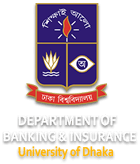Refer to Banking Stream
Course objectives: The objective of the course is to introduce the principles of reinsurance, its arrangements in business and the practice of analyzing reinsurance portfolios. The course also covers in-depth study of reinsurance market so that the students may recognize and identify important developments in the reinsurance industry and its relation with the development of direct insurance markets.
Course contents: Reinsurance fundamentals: concept, objectives, benefits, functions, parties, scope; principles of reinsurance: contract, formation of contract, subject matter, insurable interest and other principles; environment of reinsurance: history and development, Lloyd and the London reinsurance market, international reinsurance environment and trends, business and financial principles; analysis of reinsurance portfolio and needs: geographical distribution of business, identification and measurement of exposures to large risks, accumulation of losses out of one event and in a year, reserve and possibility of ruin; methods of reinsurance: pools, retrocession, facultative, facultative obligatory, treaty, proportional: quota share and surplus, non-proportional: excess of loss, top and drop cover; risk management in reinsurance: risk distribution of an insurer’s portfolio with different reinsurance arrangements, pros and cons; design and arrangement of reinsurance programs: factors influencing level of retention, fixing of retention, acceptable probability of ruin, scope of reinsurance treaties, reciprocity and negotiating terms, treaty wordings; pricing of reinsurance: different premium calculation methods; reinsurance and global market: global scenario, growth in global market.
Textbook: Reinsurance Fundamentals by Ross Phifer
Reference books:
1. Handbook on Non-life Insurance and reinsurance by A. K.M. Ehsanul Haque
2. Reinsurance Principles and Practice by Klaus Gerathewohl
Course objectives: This course is focused on the operations of personal finance and personal insurance market or life and health insurance industry. More specifically students will understand personal finance and use of life and health insurance in personal financing which help them to take decisions to choose the appropriate policy in personal financial management efficiently.
Course contents: Economic security, economics of life and health insurance, life and health insurance pricing fundamentals, life and health insurance products, whole life insurance policies, universal life insurance policies, health insurance policies, life and health insurance contracts, life and health insurance policy evaluation, life and health insurance in personal financial planning, business planning, health care plans, health insurance underwriting.
Textbook: Life and Health Insurance by Kenneth Black Jr. and Harold D. Skipper Jr
Refer to Banking Stream
Course objectives: The objective of the course is to introduce students with the knowledge of Islamic insurance named as Takaful Insurance and its basic differences with conventional insurance. The course covers in-depth study of guiding principles on governance for Takaful undertakings, challenges and opportunities, and regulation and supervision of it. Studying this course will enrich the students with the knowledge of different models used by Islamic insurance companies.
Course contents: Concept of Islamic insurance, difference between Islamic insurance and conventional insurance, contemporary issues of Takaful, models of Takaful, principles on governance for Takaful undertakings, challenges and opportunities of Takaful, regulation and supervision of Takaful, practice of Takaful in Bangladesh, problems and prospects of Takaful in Bangladesh, Takaful and global market.
Textbook: Takaful Islamic Insurance by Riffat, Archer and Volker
Reference book:Mathematical application, case studies on insurance companies andrelevant articles
Course objectives: This course essentially lays the foundation to insurance fund management through Asset-Liability Management perspective and provides a value driven approach to investment decisions for the concerned students. After completing the course, students will be able to understand the ways and means of managing the sources and uses of funds for both life and non-life insurance businesses. The primary focus underlying the course is to maximize upside and minimize downside risks.
Course contents: Impact of government policy and regulations on insurance asset liability management, financial performance analysis of insurance companies, repricing gap model, duration gap analysis and convexity, use of maturity gap model as investment vehicle, risk adjusted return on capital, value at risk framework, reserves management strategies, application of derivative instruments for hedging, stress testing within ALM mechanism, assumptions in assets and liability projections, assessment of capital risk, recent studies on ALM risks in insurance companies.
Textbook: Insurance: From Underwriting to Derivatives: Asset Liability Management in Insurance by Briys and Varenne
Reference books
1. Management of Financial Institutions by Anthony Saunders
2. Practical Course Materials on ALM practices
Course objectives: The course aims to render a good understanding of the nature and the principles of corporate strategy and their application in the field of insurance. By introducing the basic concepts and analytical tools of strategic management in insurance, this course will help to provide sound understanding of the environment in which business operates. Moreover, it seeks to identify the strategic issues faced by the insurance companies and financial services firms around the world and to position these issues in the wider economic and regulatory setting.
Course contents: Understanding the structure and management of insurance organizations: ownership models; principles of organizations, organizational structures, outsourcing and its effect; corporate governance, board and key management positions, corporate risk management, principles of planning;understanding financial issues and control mechanisms in the management of insurance organizations: financial functions; financial reporting, financial accounts of insurance organizations, international financial reporting standard; budgeting process; internal and external auditing; investment management and asset-liability management in insurance organizations; understanding regulatory issues and their impact on insurance organizations: prudential regulatory issues, including capital adequacy and solvency rules, and their impact; business regulatory issues; international harmonization of regulation; rules for data protection, anti money laundering, consumer disclosure and the prevention of bribery, credit rating; understanding the current and future challenges to the management of insurance organizations: threats and opportunities faced in managing insurance organizations.
Textbooks
1. Insurance Corporate Management, London: CII. Study Text
2. Management of Insurance Operations by Bates, I. and Atkins, D. Institute of Financial Services, London
Reference books
1. Corporate Strategy by R Lynch
2. Insurance, Legal and Regulatory. London: CII. Study Text IF1
Refer to Banking Stream
Refer to Banking Stream
Refer to Banking Stream
Refer to Banking Stream
Refer to Banking Stream
Refer to Banking Stream
Refer to Banking Stream
